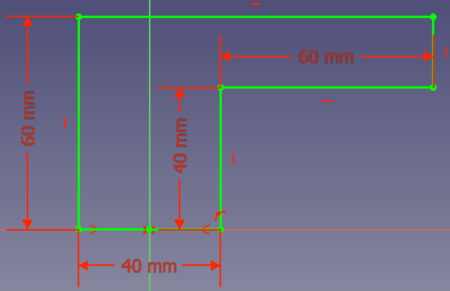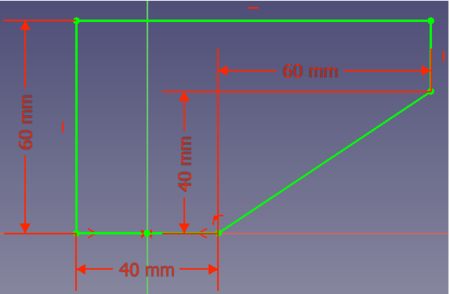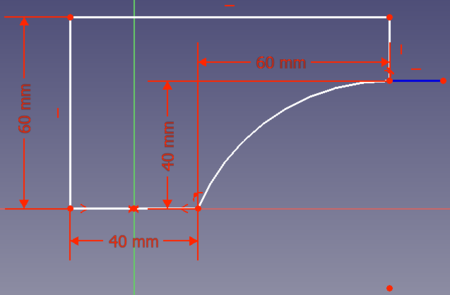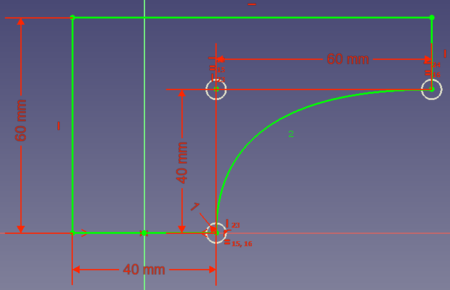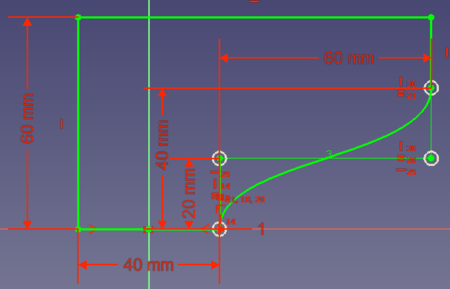B-Splines
This page describes how to use B-splines in FreeCAD. It gives also background information what B-splines are and for what applications they are useful.
Motivation
If you know already about B-splines and their application, you can directly continue with section??.
Let's assume you want to design a part that should be produced with a 3D printer. The part must have an edge this way:
You have to print the part in direction of the sketch's bottom to the top. Outer support structures might not be an option. Therefore you need to add a support directly to your part. What options do you have?
- Option 1: you could add a line from point (0, 20) to point (80, 40):
However this solution needs a lot of volume, thus weight and material.
- Option 2: you can connect the two points with an arc of a circle. To save volume, the arc should end tangentially in point (80,40). Then your solution looks like this:
OK. But at the bottom you don't need immediate support.
- Option 3: you could save some more volume if the connection between the 2 points is a circle that begins tangentially at (0, 20) and ends tangentially at (80, 40):
So a curve with which you can connect two points with any angle can be very useful for constructions.
Bézier curves
The curve used in the above option 3 is a Bézier curve. Bézier curves are polynoms to describe the connection between 2 points. The simplest polynomial connecting 2 points is a line () thus also the linear Bézier curves are linear:
Animation 1: Linear B-spline.
However a polynom becomes first be useful when we can control it. So there should be a point between the 2 endpoints that allows us to define how the endpoints are connected. Like in the above example option 3 the curve is helpful when it starts and ends tangentially to lines crossing the endpoints. And this is a main feature of Bézier curves. So let's add a control point between the 2 endpoints. The curve will start tangentially towards this control point, meaning it is tangential to the line that we can draw between the startpoint and the control point. Going backwards from the endpoint the curve will also be tangential to the line we can draw between the control point and the end point. Animation 2 shows how such a curve looks.
Animation 2: Quadratic B-spline. P1 is hereby the control point.
The animation makes clear what the curve basically is - a transition from P0 to P2 by rotating the line P0-P1 to become the line P1-P2. Therefore we get the nice tangential start/end feature.
Such a curve can only be described by a quadratic polynom. (The number of lefthand/righthand curves + 1 is the necessary polynom order ti describe such a curve. A quadratic polynom is a lefthand curve, depending from what direction you look, a cubic polynom is a combination of a lefthand and righthand curve, and so on.) Therefore a Bézier curve with one control point is a quadratic (second order) Bézier curve.
Having only control point is often not sufficient. Take above the above motivation example. There in option 3 we end the curve tangentially in x-direction. But how can you connect the points (20, 0) and (80, 40) so that the curve ends tangentially in y-direction? To achieve this you need first a righthand and then a lefthand turn, so a cubic (third order) polynom. And that means for a Bézier curve that we need (or you can say we gain) a second control point. Animation 3 shows a cubic Bézier curve.
Animation 3: Cubic B-spline.
To answer the question, the tangential Y-direction ending solution for the example is this one:
